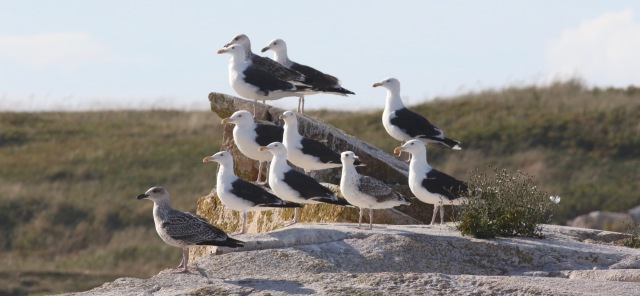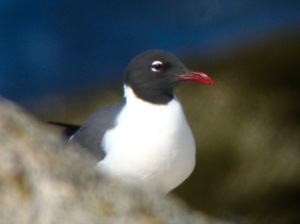First off, I’m going to ruin your childhood surety. Are you ready? Brace yourself:
There’s no such thing as a seagull.
The very word makes any birder shudder. In fact, no such creature exists. Except, that is, in the common-yet-false knowledge of the average beach-goer. Want to sound like you know your stuff in the bird realm? Call it a gull. And then, why not go ahead and take it a step further: Find out what species of gull it is. Be it the black hooded Laughing Gull or the enormous Great Black-backed Gull, the largest gull in the world, you’ll find that calling any old white bird flying around the seashore is not only wrong, it is an affront to the wide world of gulls.

Greater Black-backed Gulls
To take this a bit further, I want to address those of us who have fed these clever, opportunistic creatures. The last time I did it was more than 25 years ago and I distinctly remember the pinch of beak onto finger and the rush of joy turned to dismay. These birds will go out of their way to get your food, to the extent that you’ll hardly know how that cookie that you’d been eagerly lifting toward your open mouth suddenly became many meters away (and growing) from your empty maw, snapped up in the beak of the gull that just took you for a fool.
Whether we want to feed them or not, we are. The bits of food we leave behind are scavenged with gusto, as are the french fries strewn across all the parking lots of the world. While most birds flee at the sight of a human, gulls are sure to occupy space as near to us as they dare because generations before them have undeniably benefitted from our waste and carelessness and voluntarily-tossed breadcrumbs. They’ve learned to take advantage, to await any opportunity of food.

Laughing Gull
And they’re reaping the benefits, as portrayed by the immense populations some gull species have grown into. Here is where our impact on nature once again plays a hand, indirectly enough so that it passes under most of our awareness. This is because it’s happening in even the most remote of ecosystems. Gulls pushed out of the human populous move to more secluded areas to find food and will hunt in an opportunistic manner, perhaps following the lobster boats to distant islands, and some of these birds may find themselves suddenly looking down upon a seabird colony brimming with edibility. The island colonies are made up of ground-nesting terns, eggs barely hidden on the bare earth. Common Eiders, a species of sea duck, make their way up the beach followed by sooty cottonball chicks. Here is a vulnerability that the opportunistic gull will happily take advantage of, and with gusto.
As a 19 year old, shiny new field biologist (so designated by one Dr. Steve Kress), riding the swells of Maine’s Saco Bay to one of the nesting colonies where I’d be spending my summer, a flurry of wings that caught my attention on the beach of my soon-to-be island home. A momma eider was leading her seven fuzzy chicks up the beach and those little morsels were just too tempting for any gull to pass up. Before my jaw could even drop in disbelief, every one of the chicks had already disappeared down the gullet of one of the gang of hungry gulls.
One of the primary reasons Project Puffin is still going, forty years after its initiation, is that without a constant human presence during the breeding season, the gregarious, predatory gulls would eradicate all the other nesting species on the island. Laughing gulls will take eggs and steal the food that adult puffins and terns bring in to feed their own young, an act known as kleptoparisitism. Herring and Great Black-backed gulls will swallow an entire tern fledger whole. By the end of the summer, it’s hard to find a fledgling Common Eider anymore. They have to run the gauntlet every day and few succeed.
Nevertheless, these birds aren’t evil. They’re just sustaining themselves, just like we do every day, just heading over to the grocery store or cafe and picking up some hunk of meat or a delectable dessert. What the problem is, is us. But the more we know, the more we can help moderate how our lives impact ecosystems. And the more we know, we can share what we’ve learned with others and, best of all, better appreciate the flurry of wings around us.














Pingback: The Project Puffin Story: A Review | feathers awry
Have you found any successful deterrents for the gulls stealing catch or chicks?
LikeLike
Love your newsletter and you always have such great information for us. Hope you will be coming back to Seal Island soon.
LikeLike
This was a well written article
providing insight into the the unseen
effects our “interaction” with gulls has
on other species, specifically Puffins &
Terns. Loved the article! Thank you.
LikeLike